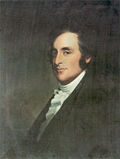| |||||||||||||||||
| |||||||||||||||||
 County results Brooks: 50-60% 60–70% 80–90% Dexter: 50–60% 60–70% No Data/Vote: | |||||||||||||||||
| |||||||||||||||||
The 1816 Massachusetts gubernatorial election was held on April 11, 1816, in order to elect the Governor of Massachusetts. Federalist candidate John Brooks defeated Democratic-Republican candidate Samuel Dexter. [1]


